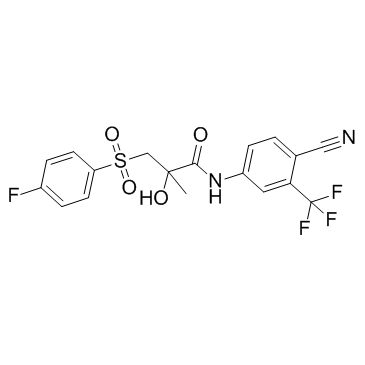Bicalutamide

Bicalutamide structure
|
Common Name | Bicalutamide | ||
|---|---|---|---|---|
| CAS Number | 90357-06-5 | Molecular Weight | 430.373 | |
| Density | 1.5±0.1 g/cm3 | Boiling Point | 650.3±55.0 °C at 760 mmHg | |
| Molecular Formula | C18H14F4N2O4S | Melting Point | 191-193°C | |
| MSDS | Chinese USA | Flash Point | 347.1±31.5 °C | |
| Symbol |

GHS07 |
Signal Word | Warning | |
|
CYP3A5 regulates prostate cancer cell growth by facilitating nuclear translocation of AR.
Prostate 75(5) , 527-38, (2015) The central role of androgen receptor (AR) signaling is established in prostate cancer growth and progression. We propose CYP3A5 is part of a feedback loop that modulates the sensitivity of AR to androgen exposure. The purpose of this study is to elucidate th... |
|
|
Differential androgen deprivation therapies with anti-androgens casodex/bicalutamide or MDV3100/Enzalutamide versus anti-androgen receptor ASC-J9(R) Lead to promotion versus suppression of prostate cancer metastasis.
J. Biol. Chem. 288(27) , 19359-69, (2013) Despite the fact that androgen deprivation therapy (ADT) can effectively reduce prostate cancer (PCa) size, its effect on PCa metastasis remains unclear. We examined the existing data on PCa patients treated with ADT plus anti-androgens to analyze ADT effects... |
|
|
TLR3 engagement induces IRF-3-dependent apoptosis in androgen-sensitive prostate cancer cells and inhibits tumour growth in vivo.
J. Cell. Mol. Med. 19(2) , 327-39, (2015) Toll-like receptors (TLRs) are a family of highly conserved transmembrane proteins expressed in epithelial and immune cells that recognize pathogen associated molecular patterns. Besides their role in immune response against infections, numerous studies have ... |
|
|
A molecular analysis provides novel insights into androgen receptor signalling in breast cancer.
PLoS ONE 10(3) , e0120622, (2015) Androgen Receptor (AR) is an essential transcription factor for the development of secondary sex characteristics, spermatogenesis and carcinogenesis. Recently AR has been implicated in the development and progression of breast and prostate cancers. Although s... |
|
|
Hydrazinobenzoylcurcumin inhibits androgen receptor activity and growth of castration-resistant prostate cancer in mice.
Oncotarget 6(8) , 6136-50, (2015) There is a critical need for therapeutic agents that can target the amino-terminal domain (NTD) of androgen receptor (AR) for the treatment of castration-resistant prostate cancer (CRPC). Calmodulin (CaM) binds to the AR NTD and regulates AR activity. We disc... |
|
|
Mechanistic rationale for MCL1 inhibition during androgen deprivation therapy.
Oncotarget 6(8) , 6105-22, (2015) Androgen deprivation therapy induces apoptosis or cell cycle arrest in prostate cancer (PCa) cells. Here we set out to analyze whether MCL1, a known mediator of chemotherapy resistance regulates the cellular response to androgen withdrawal. Analysis of MCL1 p... |
|
|
CH5137291, an androgen receptor nuclear translocation-inhibiting compound, inhibits the growth of castration-resistant prostate cancer cells.
Int. J. Oncol. 46(4) , 1560-72, (2015) Resistance of prostate cancer to castration is currently an unavoidable problem. The major mechanisms underlying such resistance are androgen receptor (AR) overexpression, androgen-independent activation of AR, and AR mutation. To address this problem, we dev... |
|
|
Increased androgen receptor activity and cell proliferation in aromatase inhibitor-resistant breast carcinoma.
J. Steroid Biochem. Mol. Biol. 144 Pt B , 513-22, (2014) Aromatase inhibitors (AI) are commonly used to treat postmenopausal estrogen-receptor (ER)-positive breast carcinoma. However, resistance to AI is sometimes acquired, and the molecular mechanisms underlying such resistance are largely unclear. Recent studies ... |
|
|
GATA3 in the urinary bladder: suppression of neoplastic transformation and down-regulation by androgens.
Am. J. Cancer Res. 4(5) , 461-73, (2014) Recent evidence suggests the involvement of sex hormone receptors in bladder cancer initiation, while precise functions of androgens and estrogens in the carcinogenesis step remain poorly understood. We recently found down-regulation of GATA3, a zinc-finger t... |
|
|
A solid-phase extraction method for rapidly determining the adsorption coefficient of pharmaceuticals in sewage sludge.
Water Res. 67 , 292-8, (2014) The partitioning of pharmaceuticals in the environment can be assessed by measuring their adsorption coefficients (Kd) between aqueous and solid phases. Measuring this coefficient in sewage sludge gives an indication of their partitioning behaviour in a waste... |